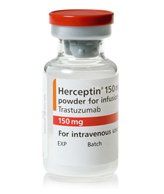T-DM1 Trial Disappoints in HER2-Positive Breast Cancer
Results of the MARIANNE trial found that HER2-positive breast cancer patients treated with T-DM1 had similar survival to those on the current standard of care.
Based on the latest results, T-DM1 will not replace trastuzumab in the first-line setting.

Results of the anticipated phase III MARIANNE trial found that HER2-positive metastatic breast cancer patients treated with ado-trastuzumab emtansine (T-DM1) plus pertuzumab had similar progression-free survival (PFS) compared with those treated with trastuzumab plus a taxane-based chemotherapy.
Though the trial met its noninferiority endpoint, showing a similar PFS in the first-line setting between the two combination therapies along with T-DM1 alone, it failed to demonstrate that T-DM1 performs better than trastuzumab plus chemotherapy.
The study has been anticipated by clinicians as two of the treatment arms do not include a taxane, which often causes patients to lose their hair, among other toxicities. The full results of the study will be presented at a future medical meeting.
The trial randomized 1,095 patients 1:1:1 to three treatment arms. The primary endpoint was PFS. Secondary endpoints included overall survival, response rate, and the incidence of adverse events. Each of the T-DM1 treatment arms-either with placebo or pertuzumab-were compared with trastuzumab plus either docetaxel or paclitaxel.
Sara Hurvitz, MD, of the UCLA Jonsson Comprehensive Cancer Center in Los Angeles, who was not involved in the trial, told Cancer Network she was surprised by the results as a randomized phase II study showed that T-DM1in the first-line setting was associated with an improved time to progression of 5 months compared with docetaxel plus trastuzumab-the MARIANNE trial did not confirm these results. Hurvitz also noted that the preclinical synergy demonstrated between T-DM1 and pertuzumab did not translate into improved clinical outcomes compared with T-DM1 alone, at least in this trial.
Patients treated in the trastuzumab plus docetaxel arm received 8 mg/kg trastuzumab as a loading dose followed by 6 mg/kg for subsequent doses. Docetaxel was given at 75 mg/m2 every 3 weeks. Patients treated in the trastuzumab plus paclitaxel arm received 4 mg/kg trastuzumab as a loading dose followed by 2 mg/kg for subsequent doses. Paclitaxel was given at 80 mg/m2 every 2 weeks. T-DM1 was administered at 3.6 mg/kg every 3 weeks and pertuzumab at an 840 mg loading dose followed by 420 mg.
Neither T-DM1 treatment arms achieved a superior PFS compared with the trastuzumab-containing regimen.
The adverse events in the MARIANNE study were generally consistent with those seen in previous studies, according to Genentech.
Both T-DM1 and pertuzumab have demonstrated the ability to extend survival for patients with HER2-positive disease.
T-DM1 was approved by the US Food and Drug Administration (FDA) in 2013 for HER2-positive patients who had previously been treated with trastuzumab and a taxane chemotherapy based on the results of the phase III EMILIA study. Patients who received T-DM1 treatment lived almost 6 months longer compared with patients receiving lapatinib plus capecitabine, the previous standard of care (median overall survival, 30.9 vs 25.1 months).
The agent also demonstrated the ability to prolong PFS in the third-line setting. The phase III TH3RESA trial showed that HER2-positive patients who had progressed on two or more previous HER2-directed therapies including trastuzumab and lapatinib, had improved PFS compared with those treated with physician’s choice of chemotherapy.
Pertuzumab is approved by the FDA in combination with trastuzumab and chemotherapy as a first-line therapy for metastatic HER2-positive breast cancer patients.
“In my opinion, given the substantial survival associated with [docetaxel plus trastuzumab and pertuzumab of over 56 months], it remains the current first-line standard regimen especially for those patients who have never been exposed to trastuzumab,” said Hurvitz.